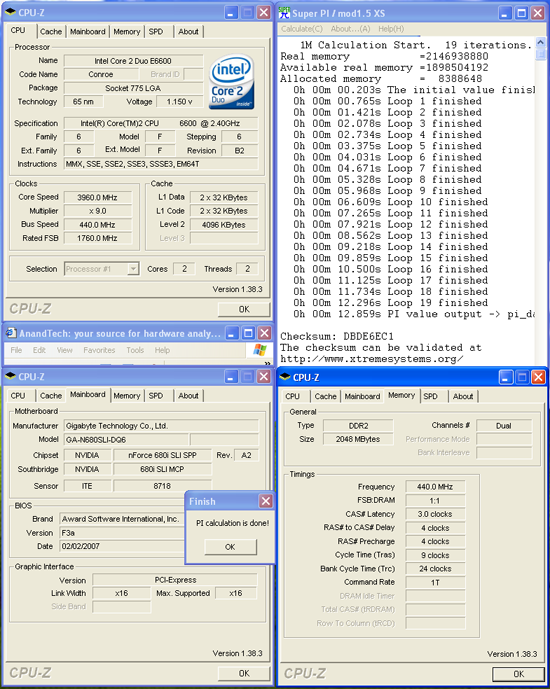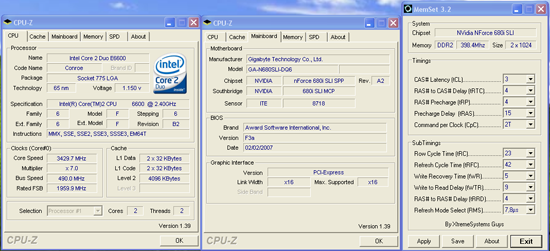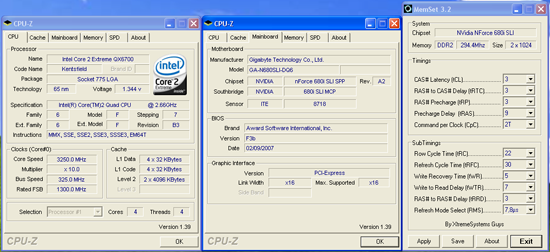Gigabyte GA-N680SLI-DQ6: Quad to the Extreme
by Gary Key on February 24, 2007 1:30 AM EST- Posted in
- Motherboards
Dual Core Overclocking
We were easily able to reach a final benchmark stable setting of 9x440 FSB resulting in a clock speed of 3960MHz. We were able to run our OCZ Flex PC2-9200 and our Corsair PC2-6400C3 at the reported timings with 1T Command Rate enabled. The shipping F2 BIOS limited us to a 9x425 setting and a 2T Command Rate. The latest F3B beta BIOS that greatly improved our quad core overclocks but limited us to a 9x430FSB setting; it also allowed 1T Command Rates at DDR2-860. Vdroop was acceptable on this board during overclocking with an average drop of .02 ~.03V during load testing.
We also tested our new OCZ Flex PC2-6400 and G.Skill F2-6400CL4D-2GBHK memory based on the ProMOS IC chips with great success. The OCZ Flex PC2-6400 was able to run at DDR2-880 (9x440) speed with timings at 3-4-4-15 2T at 2.275V and the G.Skill F2-6400CL4D at 4-4-4-8 2T at 2.250V. The balance of the memory timings were set to Auto as the BIOS was very temperamental when manually setting the timings.
We dropped the multiplier on our E6600 to seven and were able to reach 490 FSB without issue on the F3A BIOS. We were able to enter XP at 7x510 and the board would POST at 7x514. However, at least with our sample, stability over 500 FSB dropped off quickly and we feel like this BIOS release was designed with a 500FSB in mind but not much more. The F3B BIOS proved to be stable at 503 FSB and would POST at 7x518 but memory timings had to be backed off when compared to the F3A BIOS at both the DDR2-800 unlinked or DDR2-1006 synced speeds. The shipping F2 BIOS limited us to a final 7X468 setting with the same memory timings utilized in our F3A testing.
Quad Core Overclocking
Needless to say, quad core overclocking on the 680i platforms have not been spectacular and downright worrisome, considering that we have not been able to reach a stable 333FSB with any 680i board until ASUS released their 1002 BIOS for the Striker Extreme last week. We understand EVGA will be releasing a fix for their reference board design shortly so maybe the problems will be solved. In the meantime, if you are looking for high FSB overclocks with your quad core then look at the Intel P965 or AMD RD600 chipsets.
We dropped the multiplier on our QX6700 and were unable to improve upon the same 325 FSB level at the stock 10x multiplier. The board would not even POST past a 340FSB and we could enter XP at 332FSB, but it was only good for a screenshot session. We required the F3B BIOS to reach our final benchmark stable 325FSB setting as the F3A was not stable above 312 and the shipping F2 BIOS topped out at 304. Although the board is touted as being "Quad-Core optimized", we did not see it. Gigabyte engineering is working to address this shortcoming, although if it is being caused by the chipset itself they may not have much success. We will continue to monitor the situation for now.
| GIGABYTE GA-N680SLI-DQ6 Dual Core Overclocking Testbed |
|
| Processor: | Intel Core 2 Duo E6600 Dual Core, 2.4GHz, 4MB Unified Cache 1066FSB, 9x Multiplier |
| CPU Voltage: | 1.4875V (default 1.3250V) |
| Cooling: | Tuniq 120 Air Cooling |
| Power Supply: | OCZ ProXStream 1000W |
| Memory: | OCZ Flex XLC (2x1GB) (Micron Memory Chips) OCZ Flex XLC PC2-6400 (ProMOS Memory Chips) |
| Video Cards: | 1 x MSI 8800GTX |
| Hard Drive: | Western Digital 150GB 10, 000RPM SATA 16MB Buffer |
| Case: | Cooler Master CM Stacker 830 |
| Maximum CPU OC: | 440x9 (3-4-4-9 1T, 880MHz, 2.375V), CPU 1.4875V 3960MHz (+65%) |
| Maximum FSB OC: | 490x7 (3-4-4-15 2T, 800MHz, 2.275V), CPU 1.4500V 3430MHz (+84% FSB) |
| . | |
 |
| Click to enlarge |
We were easily able to reach a final benchmark stable setting of 9x440 FSB resulting in a clock speed of 3960MHz. We were able to run our OCZ Flex PC2-9200 and our Corsair PC2-6400C3 at the reported timings with 1T Command Rate enabled. The shipping F2 BIOS limited us to a 9x425 setting and a 2T Command Rate. The latest F3B beta BIOS that greatly improved our quad core overclocks but limited us to a 9x430FSB setting; it also allowed 1T Command Rates at DDR2-860. Vdroop was acceptable on this board during overclocking with an average drop of .02 ~.03V during load testing.
We also tested our new OCZ Flex PC2-6400 and G.Skill F2-6400CL4D-2GBHK memory based on the ProMOS IC chips with great success. The OCZ Flex PC2-6400 was able to run at DDR2-880 (9x440) speed with timings at 3-4-4-15 2T at 2.275V and the G.Skill F2-6400CL4D at 4-4-4-8 2T at 2.250V. The balance of the memory timings were set to Auto as the BIOS was very temperamental when manually setting the timings.
 |
| Click to enlarge |
We dropped the multiplier on our E6600 to seven and were able to reach 490 FSB without issue on the F3A BIOS. We were able to enter XP at 7x510 and the board would POST at 7x514. However, at least with our sample, stability over 500 FSB dropped off quickly and we feel like this BIOS release was designed with a 500FSB in mind but not much more. The F3B BIOS proved to be stable at 503 FSB and would POST at 7x518 but memory timings had to be backed off when compared to the F3A BIOS at both the DDR2-800 unlinked or DDR2-1006 synced speeds. The shipping F2 BIOS limited us to a final 7X468 setting with the same memory timings utilized in our F3A testing.
Quad Core Overclocking
| GIGABYTE GA-N680SLI-DQ6 Quad Core Overclocking Testbed |
|
| Processor: | Intel Core 2 Extreme QX6700 Quad Core, 2.66GHz, 8MB Unified Cache 1066FSB, 9x Multiplier |
| CPU Voltage: | 1.3625V (default 1.3500V) |
| Cooling: | Tuniq 120 Air Cooling |
| Power Supply: | OCZ ProXStream 1000W |
| Memory: | OCZ Flex XLC (2x1GB) (Micron Memory Chips) |
| Video Cards: | 1 x MSI 8800GTX |
| Hard Drive: | Western Digital 150GB 10, 000RPM SATA 16MB Buffer |
| Case: | Cooler Master CM Stacker 830 |
| Maximum OC: | 325x10 (3-3-3-9 2T, 800MHz, 2.325V), CPU 1.3625V 3250MHz (+22%) |
| . | |
 |
| Click to enlarge |
Needless to say, quad core overclocking on the 680i platforms have not been spectacular and downright worrisome, considering that we have not been able to reach a stable 333FSB with any 680i board until ASUS released their 1002 BIOS for the Striker Extreme last week. We understand EVGA will be releasing a fix for their reference board design shortly so maybe the problems will be solved. In the meantime, if you are looking for high FSB overclocks with your quad core then look at the Intel P965 or AMD RD600 chipsets.
We dropped the multiplier on our QX6700 and were unable to improve upon the same 325 FSB level at the stock 10x multiplier. The board would not even POST past a 340FSB and we could enter XP at 332FSB, but it was only good for a screenshot session. We required the F3B BIOS to reach our final benchmark stable 325FSB setting as the F3A was not stable above 312 and the shipping F2 BIOS topped out at 304. Although the board is touted as being "Quad-Core optimized", we did not see it. Gigabyte engineering is working to address this shortcoming, although if it is being caused by the chipset itself they may not have much success. We will continue to monitor the situation for now.










12 Comments
View All Comments
sirius4k - Thursday, May 17, 2007 - link
Overview in Gigabyte' website said there will be some eSATA (Quad eSATA or something) ports. On this preview... read panel indicates no eSATA ports :S---
No eSATA means going back to Striker Extreme... of course.
yacoub - Friday, March 30, 2007 - link
The reviews at NewEgg are tearing this board a gaping butthole. I'm staying away. :[Gary Key - Monday, April 2, 2007 - link
Every review at NewEgg was either a four or five star rating for this board. Where are the bad ones?Binkt - Monday, March 19, 2007 - link
Can someone over there put in a few PCI-E RAID cards in those extra PCI-E slots and see if they function? The Areca SATA RAID cards (ARC-12x0ML) are what I'm looking at right now. Pretty please?!There is a rather cryptic FAQ entry on using PCI-E for "graphics" slots on Areca's website in regards to this subject. I'd just like some more physical validation before plunking down the green.
erwos - Monday, February 26, 2007 - link
Am I the only one who's totally and utterly confused as to why this board has four ethernet interfaces? I can see using two interfaces. I could even contemplate three for really weird setups. But what networking setup requires four gigabit interfaces? Are they supposed to be bonded, or used for fail-over?Speaking purely as a gamer, the MSI P6N Diamond looks like a better deal. It may be shorter on the ports, but that built-in X-Fi seems a lot more handy than a couple more SATA and ethernet ports.
Gary Key - Monday, February 26, 2007 - link
1. XP Professional will show 3.25GB of RAM when 4GB is installed. The board will show 4GB at POST.2. The RAM timings will drop with 4 x1GB when overclocking, at stock speeds with the F3 BIOS they require an additional .0125V to operate at the same timings.
3. The timings matter when using 2x2GB compared to 2x1GB,512MB, however at same timings we found 2X2GB was generally more stable and performance did not vary more than a percent or two.
4. If you use a 32-bit OS such as XP you are limited to 3.25GB of usable memory space.
5. This board did not have an issue with Vista-64 and recognizing 4GB or 8GB of memory, as stated in the article we are still conducting memory compatibility testing as certain modules perform better than others (stability, voltages, timings), even though they are based on the same IC. Gigabyte still has some tuning work to do in this area.
Thanks, more information will be in the roundup.
anandtech02148 - Saturday, February 24, 2007 - link
per example dfi infity 975g requireds 300watts just to post.also what is the idle /load for this? more electricity mo heat.
cornfedone - Saturday, February 24, 2007 - link
...or don't. As long as gullible, foolish fanboys buy these defective products, there is no FINANCIAL incentive for these unscrupulous companies to change their ways and deliver quality products.Obviously if every hardware review site on the planet can duplicate the unending operational (and often design/engineering) defects in these mobos, then certainly the mobo and chip makers could detect these defects BEFORE they ship this crap if they weren't intentionally pumping garbage out the door to suckers willing to pay $200 plus for a mobo that is a total POS.
There is absolutely NO reason to release a defective hardware product today other than financial greed and/or technical incompetence. Hell most of the Asian mobo companies can't even make a friggin quality copy of a reference mobo from AMD or ATI so why would you expect them to deliver a properly functioning "performance mobo" priced at hundred of dollars more when they can't buy a clue?
With any luck all of the slimy mobo makers will go tits-up soon and the real mobo companies will see an opportunity to provide quality mobos to the marketplace. At $200 a copy there is one Helleva incentive for honest, competent mobo companies to step forward and waste the Asian scum who are dumping crap into the marketplace. When a $200 plus mobo causes data corruption it's time for a massive class action lawsuit to end this consumer fraud and exploitation.
Now is the time.
sdsdv10 - Tuesday, February 27, 2007 - link
Cornfedone, what major motherboard manufacturer isn't in Asia? It appears you are painting all the current companies with the same bruch, Asus, Gigabyte, abit... Who would be left to be the "honest, competent mobo companies"?
tuteja1986 - Sunday, February 25, 2007 - link
Well Gigabyte GA-N680SL-DQ6 isn't even selling it. It will sale next month. They still have time to fix the bugs. Anyways i say buying the striker at launch for $400 was a foolish thing to do since it was buggy as hell. It took for them months to fix the problem.